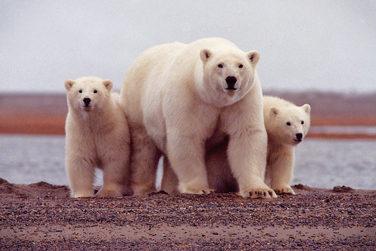News
Polar bear evolution tracked
climate change, new DNA study finds

An international study led by researchers at Penn State and UB found evidence that the size of the polar bear population fluctuated with key climatic events over the past million years. Photo: Susanne Miller, U.S. Fish and Wildlife Service
-
 Print
Print -
 Comments
Comments
-

“They (polar bears) have indeed lost a lot of their past genetic diversity, and because of this, they are very likely more sensitive to climate-change threats today.”
An analysis of newly sequenced polar bear genomes is providing important clues about the species’ evolution, suggesting that climate change and genetic exchange with brown bears helped create the polar bear as we know it today.
The international study, led by the Pennsylvania State University and UB, found evidence that the size of the polar bear population fluctuated with key climatic events over the past million years, growing during periods of cooling and shrinking in warmer times.
The research also suggests that while polar bears evolved into a distinct species as many as 4-5 million years ago, the animals may have interbred with brown bears until much more recently.
These intimate relations may be tied to changes in the Earth’s climate, with the retreat of glaciers bringing the two species into greater contact as their ranges overlapped, says Charlotte Lindqvist, the study’s senior author and UB assistant professor of biological sciences.
“Maybe we’re seeing a hint that in really warm times, polar bears changed their lifestyle and came into contact, and indeed interbred, with brown bears,” says Stephan Schuster, co-lead author, a professor of biochemistry and molecular biology at Penn State, and a research scientist at Nanyang Technological University in Singapore.
The findings were published online Monday in the early edition of the Proceedings of the National Academy of Sciences. The study is the most extensive analysis to date of polar bear DNA, scientists say.
The research team, representing 13 institutions in the U.S., Canada, Europe and Asia, as well as Mexico’s Laboratorio Nacional de Genomica para la Biodiversidad (Langebio), sequenced and analyzed the nuclear genomes of 28 different bears, with many DNA samples provided by the U.S. Geological Survey and the Norwegian Polar Institute.
“We generated a first-rate set of data, including deep sequence coverage for the entire genomes of a polar bear, three brown bears and a black bear, plus lower coverage of 23 additional polar bears, including a 120,000-year-old individual; very few vertebrate species have such comprehensive genomic resources available,” Schuster notes.
Using this vast amount of data, the scientists discovered that polar bears are actually an older species than previously thought—indeed, far more ancient than suggested by a recent study that placed the species’ age at 600,000 years old. That analysis looked only at small segments of DNA.
“We showed, based on a consideration of the entire DNA sequence, that earlier inferences were entirely misleading,” said study co-lead author Webb Miller, a Penn State professor of biology and computer science and engineering. “Rather than polar bears splitting from brown bears a few hundred thousand years ago, we estimate that the split occurred 4-5 million years ago.”
“This means polar bears definitely persisted through warming periods during Earth’s history,” Lindqvist says. She cautions, however, that the species’ endurance over several million years doesn’t guarantee its future survival.
To model historical populations of the polar bear, the scientists used computer simulations to analyze a deeply sequenced polar bear genome.
“This is the first time we can see, from their genes, how the population history of polar bears tracked Earth’s climate history,” Lindqvist says. “We see an increase in polar bears at the end of the Early Pleistocene as the Earth became much colder, and a continuous decline in the size of the population during warmer times.
“We also found, perhaps unsurprisingly, that polar bears occur in much smaller numbers today than during prehistory,” she continues “They have indeed lost a lot of their past genetic diversity, and because of this, they are very likely more sensitive to climate-change threats today.”
Discrepancies between the estimated age of polar bears in the new study and past studies could be explained by interbreeding between polar bears and brown bears since the species split from each other.
The new analysis uncovered more genetic similarities than previously known between polar bears and ABC brown bears, an isolated group from southeastern Alaska—suggesting that these animals have exchanged genes since becoming separate species.
“The ABC brown bears’ mitochondrial sequences are much more like polar bears’ than like other brown bears’,” Miller says. “This made us wonder what other parts of their genomes are ‘polar-bear-like.’ We mapped such regions, which constitute 5 to 10 percent of their total DNA, onto the genomes of two ABC brown bears. As such, brown/polar bear hybridization, which has been observed recently in Arctic Canada, has undoubtedly contributed to shaping the modern polar bear’s evolutionary story.”
This intermingling between species is just one interesting finding emerging from the enormous trove of data that the PNAS study produced. Another question that the research is beginning to address: What makes a polar bear a polar bear?
Polar bears have genetic differences from brown bears that let them survive in an Arctic climate with very different diets and the new study identified genes that may be responsible for traits such as polar bears’ pigmentation and the high fat content of their milk.
This study received financial support from Penn State, the UB College of Arts and Sciences, U.S. Geological Survey’s Changing Arctic Ecosystem Initiative, U.S. Fish and Wildlife Service, Ontario Ministry of Natural Resources in Canada, Alaska Department of Fish and Game, the National Institutes of Health and the National Science Foundation.

Reader Comments